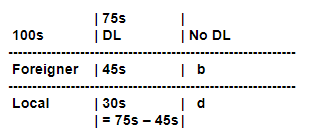[GMAT math practice question]
At a certain university, 75% of students have driver’s licences and 60% of the students with driver’s licences are foreign students. What percentage of the total students are foreign students without a driver’s licence?
1) There are 5,000 students at the university.
2) 55% of students at the university are foreigners.
=>
Forget conventional ways of solving math questions. For DS problems, the VA (Variable Approach) method is the quickest and easiest way to find the answer without actually solving the problem. Remember that equal numbers of variables and independent equations ensure a solution.
The first step of the VA (Variable Approach) method is to modify the original condition and the question, and then recheck the question.
Attachment:
 A.png [ 2.57 KiB | Viewed 3907 times ]
A.png [ 2.57 KiB | Viewed 3907 times ]
45s + 30s + b + d = 100s.
b + d = 25s.
The question asks for the value of b / 100s.
To solve problems involving 2x2 matrices and percentages, we need 3 percentages. Since we have 2 percentages, 75% and 60%, one more percentage is required.
Condition 1) does not provide a percentage, while condition 2) gives us a percentage. So, the answer is most likely to be B.
Condition 1)
100s = 5,000.
s = 50.
This is not sufficient.
Condition 2)
45s + b = 55s
b = 10s
Thus (b/100s)*100 = (10s/100s)*100 = 10 %.
This is sufficient.
Therefore, the answer is B.
Answer: B

